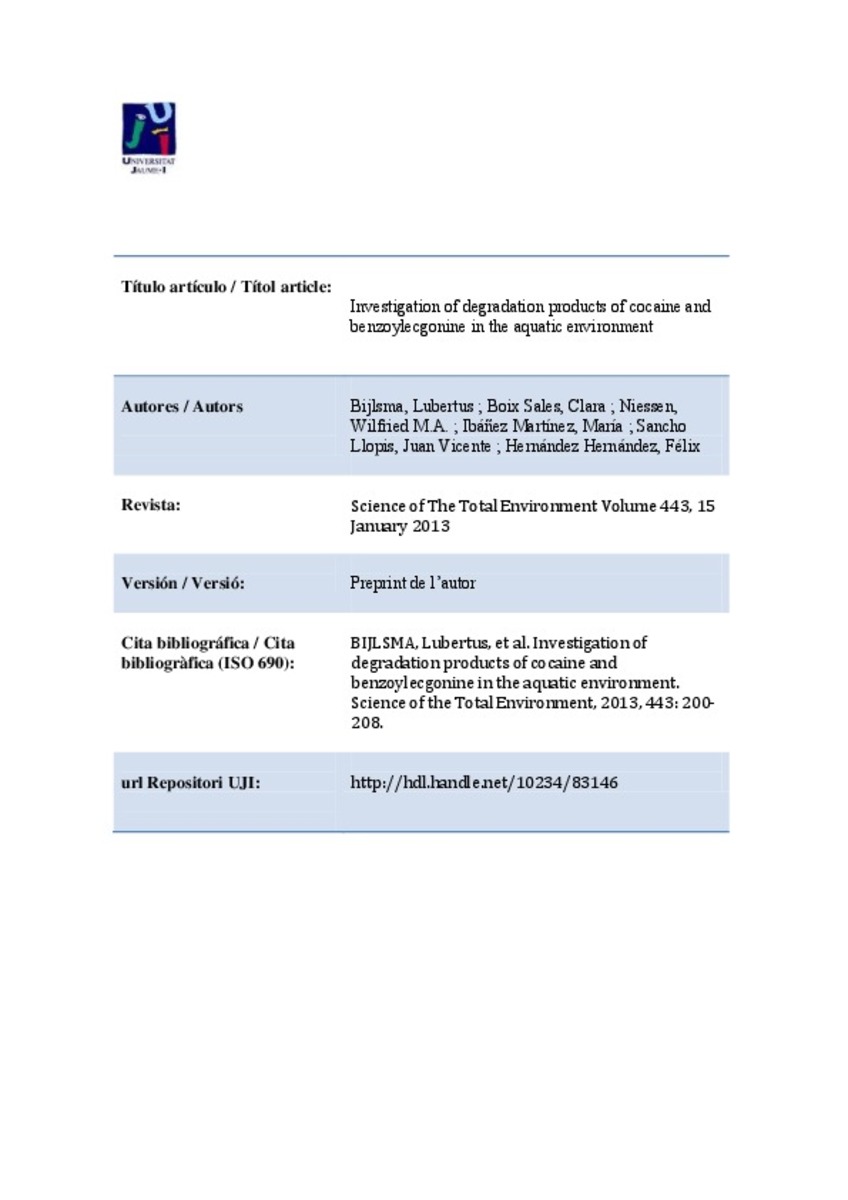Mostrar el registro sencillo del ítem
Investigation of degradation products of cocaine and benzoylecgonine in the aquatic environment
| dc.contributor.author | Bijlsma, Lubertus | |
| dc.contributor.author | Boix Sales, Clara | |
| dc.contributor.author | Niessen, Wilfried M. A. | |
| dc.contributor.author | Ibáñez, Maria | |
| dc.contributor.author | Sancho, Juan V | |
| dc.contributor.author | Hernandez, Felix | |
| dc.date.accessioned | 2014-02-11T13:17:28Z | |
| dc.date.available | 2014-02-11T13:17:28Z | |
| dc.date.issued | 2013-01 | |
| dc.identifier.citation | BIJLSMA, Lubertus, et al. Investigation of degradation products of cocaine and benzoylecgonine in the aquatic environment. Science of the Total Environment, 2013, 443: 200-208. | ca_CA |
| dc.identifier.uri | http://hdl.handle.net/10234/83146 | |
| dc.description.abstract | In this work, ultra-high-performance liquid chromatography (UHPLC) coupled to a hybrid quadrupole time-of-flight mass spectrometer (QTOF MS) has allowed the discovery and elucidation of degradation products of cocaine and its main metabolite benzoylecgonine (BE) in water. Spiked surface water was subjected to hydrolysis, chlorination and photo-degradation (both ultraviolet irradiation and simulated sunlight). After degradation of cocaine, up to sixteen compounds were detected and tentatively identified (1 resulting from hydrolysis; 8 from chlorination; 7 from photo-degradation), three of which are well known cocaine metabolites (BE, norbenzoylecgonine and norcocaine). Regarding BE degradation, up to ten compounds were found (3 from chlorination; 7 from photo-degradation), including one known metabolite (norbenzoylecgonine). Since reference standards were available for the major metabolites, they could be confirmed using information on retention time and fragment ions. The other degradates resulted from chlorination, dealkylation, hydroxylation and nitration, or from a combination of these processes. Several influent and effluent sewage water, and surface water samples were then screened for the identified compounds (known and unknown) using UHPLC–tandem MS with triple quadrupole. BE, norcocaine and norbenzoylecgonine were identified in these samples as major metabolites. Four previously unreported degradates were also found in some of the samples under study, illustrating the usefulness and applicability of the degradation experiments performed in this work. | ca_CA |
| dc.format.extent | 8 p. | ca_CA |
| dc.format.mimetype | application/pdf | ca_CA |
| dc.language.iso | eng | ca_CA |
| dc.publisher | Elsevier | ca_CA |
| dc.relation.isPartOf | Science of The Total Environment Volume 443, 15 January 2013 | ca_CA |
| dc.rights | ELSEVIER © 2013 | |
| dc.rights.uri | http://rightsstatements.org/vocab/InC/1.0/ | * |
| dc.subject | Cocaine | ca_CA |
| dc.subject | Degradation and transformation products | ca_CA |
| dc.subject | Water | ca_CA |
| dc.subject | Time-of-flight mass spectrometry | ca_CA |
| dc.subject | Cocaina | ca_CA |
| dc.subject | Agua | ca_CA |
| dc.subject | Espectrometría de masas | ca_CA |
| dc.subject.other | Espectrometria de masses | ca_CA |
| dc.subject.other | Cocaïna | ca_CA |
| dc.subject.other | Descomposició (Química) | ca_CA |
| dc.title | Investigation of degradation products of cocaine and benzoylecgonine in the aquatic environment | ca_CA |
| dc.type | info:eu-repo/semantics/article | ca_CA |
| dc.identifier.doi | http://dx.doi.org/10.1016/j.scitotenv.2012.11.006 | |
| dc.rights.accessRights | info:eu-repo/semantics/openAccess | ca_CA |
| dc.relation.publisherVersion | http://www.sciencedirect.com/science/article/pii/S0048969712014234 | ca_CA |
| dc.type.version | info:eu-repo/semantics/submittedVersion |
Ficheros en el ítem
Este ítem aparece en la(s) siguiente(s) colección(ones)
-
IUPA_Articles [306]







